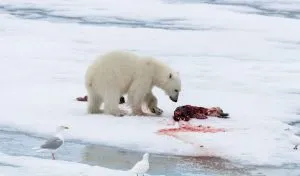Black and brown bear meat is often eaten in areas where they are abundant so you might assume that polar bears (ursus maritimus) can be eaten too. But, with their different habitat and diet, questions are raised about the safety of it. Well, let’s put the question to bed, can you eat polar bear?
Yes, you can eat polar bear meat as native people have done for centuries. You should ensure it is well cooked and never eat it raw because it often contains Trichinella parasites that can cause illness. You must also avoid its liver which can cause the deadly Hypervitaminosis A.
However, it does not taste great and since it is illegal to hunt polar bears in most Arctic countries (unless you are a native), it’s unlikely that you’ll ever get the chance anyway.
Keep reading to find out more about the perils of eating polar bear meat and some famous cases where it has gone wrong.
Is Polar Bear Meat Poisonous?
Polar bear meat itself is not poisonous if prepared correctly and the liver is avoided. The meat has been part of the native diet for many centuries.
1. Polar bear meat should never be eaten raw and must be cooked well enough
Like other bear species and even dogs, polar bear meat can contain the trichinella parasite which can cause trichinellosis when consumed by humans.
Mild symptoms such as nausea and diarrhea can start to appear after a few days. More serious symptoms can take up to 8 weeks to appear and may include swelling of the face, aching joints, heart and breathing problems, and even death1 (source: CDC).
However, trichinellosis can be avoided by properly cooking the meat before eating it.
The CDC recommends cooking meat to an internal temperature of 71.1°C (160°F) and checking this with a meat thermometer to ensure any parasites are killed2 (source: CDC).
2. Polar bear liver is highly toxic to humans and must be avoided.
A polar bear’s liver is toxic to humans because it contains high levels of vitamin A. This happens because the polar bear is at the top of its food chain. Just 1g of polar bear liver contains 1.3 to 1.8 times a human’s maximum daily vitamin A intake.
A polar bear’s liver can contain 13,000-18,000 i.u (international units) of vitamin A per gram3 (source: Biochem Journal, K. Rodahl and T. Moore, Vol 37, No. 2, 1943), so a typical 85g serving of liver can contain up to 1.5 million i.u. The recommended maximum a human should ingest per day is 10,000 i.u4 (source: Healthline).
When a human consumes too much vitamin A, it causes Hypervitaminosis A. This can result in bone pain, peeling skin, and hair loss5 (source: Healthline). There are also instances of it causing death, more on this below.
Can You Die From Eating Polar Bear?
Yes, you can die from eating polar bear, this could be due to Hypervitaminosis A from consuming too much of their liver or from trichinellosis if you do not cook the meat well enough to kill any trichinella parasites.
Trichinellosis has long been a cause of death among explorers in the Arctic. One of the most famous instances of dying from polar bear meat comes from Norwegian explorer Jens Munk in the 1600s when he saw polar bears for the first time.
He shot the polar bear, soaked it in vinegar, and shared it with his men the next day. At the time, he wrote in his journal, “It was of good taste and did not disagree with us”.
Little did he know that the following months would see most of his men die from scurvy and trichinosis from eating undercooked polar bear meat6 (source: Outside Online).
Do Arctic People Eat Polar Bear?
Yes, native communities in the Arctic, such as Inuits in North America and Yupiit in Russia, do hunt and eat polar bears. This forms part of their diet alongside birds, caribou, seals, walrus, whales, and fish.
Although most Arctic countries have made it illegal to hunt polar bears due to conservation efforts, there are usually exceptions for native populations providing they adhere to certain quotas.
Polar bears contain a lot of blubber which helps natives keep warm in the winter.
Despite having eaten polar bear meat for centuries, outbreaks of trichinellosis from undercooked meat do still occur. However, more stringent requirements for testing on meat for public sale have seen fewer outbreaks in recent times than in the 1940s and 1950s when they were more common7 (source: Veterinary Parasitology, L.N. Møller, et al, Vol 132, No. 1-2, 2005).
What Does Polar Bear Meat Taste Like?
We have not eaten polar bear meat ourselves, and do not plan to. However, we have trawled online forums to find out what others think, although we cannot reliably claim they are truthful. Here is what we found:
Most people suggest that polar bear meat has a taste and texture similar to beef, only much greasier. Some people suggest there is a hint of fishiness too which is understandable considering the polar bear’s diet of marine mammals.
One American explorer and medical officer, Dr. Elisha Kent Kane, described polar bears as ‘sweet and tender”’ but suggested the meat of lean polar bears tastes better. This is because well-fed polar bears contain high levels of fatty oil throughout their cellular tissue8 (source: Ice Bear: The Cultural History of an Arctic Icon, M. Engelhard, 2017).
.




![Read more about the article How Long Do Polar Bears Live? [Lifespan and Causes of Death]](https://polarguidebook.com/wp-content/uploads/2021/09/how-long-do-polar-bears-live-300x176.jpg)
![Read more about the article How Do Polar Bears Reproduce? [Full Reproductive Cycle]](https://polarguidebook.com/wp-content/uploads/2021/09/how-do-polar-bears-reproduce-300x176.jpg)